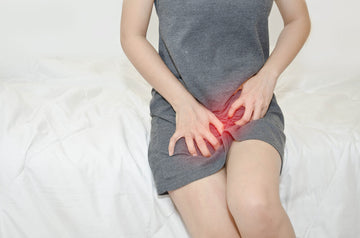Excessive sweating in intimate areas is a common difficulty that many women face, in particular in warmer climates or all through physical activities. A sweaty vagina can result in discomfort, inflammation, and even an increased danger of infections if now not controlled well. While sweating is a natural physical feature that facilitates altered temperature, excessive moisture in this touchy vicinity can disrupt daily activities and affect self-assurance. Understanding the reasons for this and adopting decisive preventive measures can drastically lessen discomfort. There are practical ways to address this issue, from retaining proper vaginal hygiene and deciding on breathable fabric to using specialized merchandise. This blog provides eight essential tips to help you stay clean, snug, and confident.
What is Sweaty Vagina?
A sweaty vagina refers to the level of increased perspiration inside the genital region, leading to a moist and probably uncomfortable feeling. This sweating may result from various factors, including warmth, high humidity, bodily interest, hormonal changes (like at some point of menstruation, pregnancy, or early menopause), wearing tight or non-breathable apparel, or even situations like obesity or hyperhidrosis.
The sweat can cause irritation, chafing, and moist surroundings that could increase the risk of infections. Managing those elements with proper hygiene, breathable apparel, and staying calm can help reduce discomfort related to a sweaty vagina.
Reasons for Sweaty Vagina
Vaginal Sweating occurs as a natural part of the body’s mechanism to adjust temperature. The vulva and surrounding regions have sweat glands, like other body parts, and sweating is common, especially in warm weather, during exercise, or while sporting tight or non-breathable apparel.
Heat and Humidity
Due to its size and skin folds, the genital area is warm. This creates a micro-environment that traps heat and promotes sweating. Hot weather and high humidity increase this problem. The body produces sweat to alter temperature; the groin, with its many sweat glands, is no exception.
Tight and Synthetic Clothing
Tight pants, leggings, or underclothes restrict airflow to the genital area. This traps warmth and sweat, making the area more prone to moisture buildup and causing a sweaty vagina. Materials like nylon, polyester, or spandex do not allow the skin to breathe, worsening sweating and discomfort.
Hormonal Changes
Hormonal fluctuations during the menstrual cycle, such as significantly higher estrogen levels, can increase body temperature and sweating. Hormonal surges at some point during pregnancy frequently elevate body temperature, leading to excessive sweating, mainly in regions like the groin.
Hot flashes and nighttime sweats due to fluctuating estrogen levels in the course of menopause can also result in sweating in the genital area. Hormonal contraceptives can, on occasion, have an effect on sweat secretion as a side effect.
Hyperhidrosis
Hyperhidrosis is a medical condition in which certain areas, including the groin, sweat excessively beyond what is needed for temperature regulation. Stress, anxiety, or genetic predisposition can exacerbate this condition. A health practitioner might encourage treatments such as prescription antiperspirants, medicines, or Botox injections.
Poor Hygiene
Not washing the area daily or leaving sweat and moisture on the pores and skin for too long can create moist surroundings. This can result in bacterial vaginosis or fungal infections, which thrive in wet conditions. To keep the area dry and clean, clean it with warm water and mild cleaning soap daily and change out of sweaty or damp apparel promptly.
8 Tips to Prevent Sweaty Vagina
Tips to prevent a sweaty vagina are as follows:
Wear Breathable Clothing
Cotton is a herbal fiber that lets air flow freely. It absorbs moisture well and dries quickly, which enables it to keep the vaginal area dry and snug. Avoid synthetic materials like nylon or polyester, which could lure heat and moisture, mainly to sweaty and uncomfortable surroundings.
Change Underwear Regularly
Regularly changing your undies prevents the increase of bacteria and fungi. Moisture from sweat can be acquired, developing a perfect environment for those microorganisms. Changing into clean, dry underclothes throughout the day, specifically after activities like workouts or if you sweat a lot, can assist in preventing discomfort and infections.
Keep the Area Dry
After bathing or sweating, it’s essential to dry the genital place nicely to avoid moisture accumulation. Patting the area dry with a clean towel in preference to rubbing can prevent infection and friction, which could cause discomfort and potentially cause skin conditions. Drying the area ultimately reduces the chance of vaginal yeast infections and bacterial increase.
Avoid Fitting Clothes
Tight clothing, especially the ones made from artificial substances, can cause heat and moisture in opposition to the skin. This can cause increased sweating and surroundings conducive to fungal and bacterial increase. Loose, breathable clothing allows the pores and skin to respire and reduces moisture build-up, possibly preventing pain and infection.
Use Absorbent Panty Liners
Panty liners can be beneficial for soaking up extra moisture from sweat during the day. They provide a protective layer, mainly for the duration of activities that could result in increased sweating. Liners can help keep the place drier and more comfortable by stopping moisture buildup on the pores and skin and in the undies.
Stay Dry During Physical Activities
Wearing moisture-wicking workout clothes can help hold the vaginal area dry at some point during exercise. These clothes are designed to attract moisture far away from the skin and to the outer layers of the cloth, where it could evaporate more quickly. This reduces the chance of excessive humidity and sweating, which could lead to discomfort and increased bacteria or yeast.
Maintain Good Personal Hygiene
Regularly washing the genital location with water and moderate soap allows for maintaining the wholesome stability of microorganisms and yeast. Avoiding douching is vital because it can disrupt the natural pH of the vaginal, potentially leading to infections or pain.
Use Talcum Powder or Cornstarch
Applying a small amount of talcum powder or cornstarch inside the underclothes can help remove excess moisture and keep the location dry. These powders are potent in lowering friction and stopping chafing, which can arise in wet surroundings. However, applying them sparingly and handiest on regions at risk of sweating is essential.
Does Sweaty Vagina Cause Odor?
Sweating in the genital region creates a warm and moist environment that can cause an increase in microorganisms and yeast. These microorganisms thrive in a damp, heated environment and can produce ugly odors. While sweat is usually odorless, it can lead to a musty or fishy odor when it combines with microorganisms and yeast.
Good hygiene practices, including keeping the place dry, using breathable fabric, and washing frequently, can help prevent this problem. However, the smell persists or is accompanied by different signs like itching, burning, or unusual discharge. In that case, it can indicate an underlying infection or imbalance that a healthcare provider needs to examine.
Conclusion
Managing a sweaty vagina involves keeping exact hygiene, wearing breathable fabrics, and using absorbent products like panty liners for women. Regularly converting underclothes and choosing unfastened, moisture-wicking apparel can save you excess sweating. Staying hydrated, keeping a healthful weight loss routine, and handling strain also are vital for typical body fitness, together with vaginal comfort. By incorporating those practices, you can substantially reduce discomfort and prevent excessive sweating, selling extra comfortable and hygienic surroundings. Remember, if symptoms persist or get worse, consulting a healthcare provider is really helpful in ruling out any underlying problems.
FAQ’s
1. Is It Normal For The Vagina To Sweat?
Yes, it is entirely normal. Like other parts of the body, the vulva has sweat glands, particularly apocrine glands, which are responsible for sweat production. Physical activity, heat, or tight clothing can increase sweating in this area.
2. Can Shaving Or Waxing In A Vaginal Area Help With Sweating?
Removing pubic hair might help reduce moisture build-up, which can contribute to sweating and odor. However, it’s a personal choice, and hygiene is more important than hair removal.
3. How Does Diet Impact Sweating In The Vaginal Area?
Certain foods, such as spicy dishes, caffeine, and alcohol, can increase body temperature and trigger sweating. Including hydrating foods like cucumber, watermelon, and leafy greens may help regulate body temperature.
4. Can Excessive Sweating Lead To Infections?
Excessive moisture can create an environment where bacteria and yeast thrive, potentially leading to infections like yeast infections or bacterial vaginosis. Keeping the area dry and clean and wearing breathable fabrics can help prevent this.
5. When Should I Consult A Doctor About Sweating In The Vaginal Area?
If vaginal sweating is excessive, persistent, or accompanied by symptoms like unusual discharge, itching, or pain, it’s essential to consult a healthcare provider to rule out any underlying issues.





